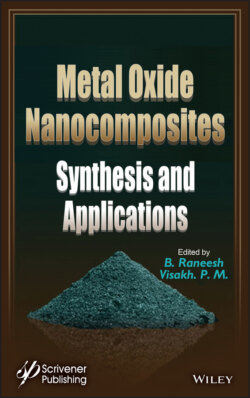Читать книгу Metal Oxide Nanocomposites - Группа авторов - Страница 18
1.6 Metal Oxide Nanocomposites and its Thermal Property Analysis
ОглавлениеMetal nanoparticles, due to their special properties and also small dimensions, find important applications in optical, magnetic, thermal, sensoric devices, catalysis, etc. Metals are dominated by the collective oscillation of conduction electrons resulting from the interaction with electromagnetic radiation. In addition to these, many production processes include heat transfer in various forms; it might be the cooling of a machine tool, pasteurization of food, or the temperature adjustment for triggering a chemical process. In most of these applications, heat transfer is realized through some heat transfer devices; such as, heat exchangers, evaporators, condensers, and heat sinks [96–98]. The feasibility of the usage of such suspensions of solid particles with sizes on the order of 2 mm or μm was previously investigated by several researchers and significant drawbacks were observed. These drawbacks are sedimentation of particles, clogging of channels and erosion in channel walls, which prevented the practical application of suspensions of solid particles in base fluids as advanced working fluids in heat transfer applications [99, 100]. Two-step method is the most widely used method for preparing nanofluids. Nanoparticles, nanofibers, nanotubes or other nanomaterials used in this method are first produced as dry powders by chemical or physical methods. Metal, metal oxide and various carbonaceous and nanocomposite based nanofluids are prepared by this method. The surfactants used in this method for stabilization can lower the thermal conductivity [101]. So the nanofluids prepared by this method exhibit lower thermal conductivity compared to the ones prepared by one-step method.
The formation of silver nanowires was explained by the in situ precipitation of a lamellar silver thiolate, Ag(SC12H), acting as a template for the 1D coalescence of isotropic Ag nanoparticles. Heterogeneous nucleation has also proved to be an efficient method for the control of the particle growth. Using Ruthenium as a seed (Ru is more easily reducible than cobalt or nickel), allows to get nickel–cobalt or cobalt nanowires [102, 103]. The synthesis of metal nanoparticles can be commonly carried out by chemical reduction, electrochemical reduction [104] and thermal decomposition [105] also induced by microwave heating [106–108]. Through the synthetic methodology, it is possible to vary the morphology, size and size distribution of M-NPs. Strong reducing agents such as sodium hydride seldom control the size and shape of M-NPs but mild reducing agents such as sodium citrate and ascorbic acid [109] which simultaneously act as coordinating capping ligands can control the size and shape of metal Nps. The biphasic synthesis can be carried out quickly under ambient conditions, permits the use of a variety of phosphines as passivating ligands, and provides control over particle core size to produce 1.5-nm nanoparticles [110].
Phosphine-stabilized nanoparticles are precursors to other functionalized nanoparticle building blocks where nearly any functional group can be introduced into the ligand shell, and the metal core size can be tuned from 1.4 to 10 nm in diameter through ligand exchange reactions [111]. Prasher et al. [112] compared the effect of translational Brownian motion and convection induced by Brownian motion. They also considered the existence of an interparticle potential. Evans et al. [113] theoretically showed that the thermal conductivity enhancement due to Brownian motion is a very small fraction of the thermal conductivity of the base fluid. This fact was also verified by molecular dynamics simulations. The clustering effect as the main reason of thermal conductivity enhancement was made by Keblinski et al. [114]. They analyzed the experimental data for thermal conductivity of nanofluids and examined the potential mechanisms of anomalous enhancement. Enhancement mechanisms such as microconvection created by Brownian motion of nanoparticles, nanolayer formation around particles, and near field radiation were concluded not to be the major cause of the enhancement. Turanov and Tolmachev used NMR technique to measure the self-diffusion coefficient of water in silica nanoparticle suspensions, and they confirmed the reduced mobility of water molecules in the proximity of solid-liquid interface. Besides density and self-diffusivity, several works also focused on the water viscosity and solid–liquid interfaces, shedding light on the differences from the bulk region [115–120]. Prasher et al. [121] demonstrated that the aggregation of nanoparticles can significantly enhance the thermal conductivity of nanofluids. They assumed that a fractal cluster is embedded within a sphere with a radius equal to the radius of gyration Rg and is composed of several approximately linear chains, which span the entire cluster and side chains. These linear chains are called the backbone of the cluster, while the other particles are called dead ends [121, 122].
